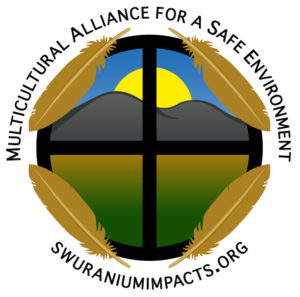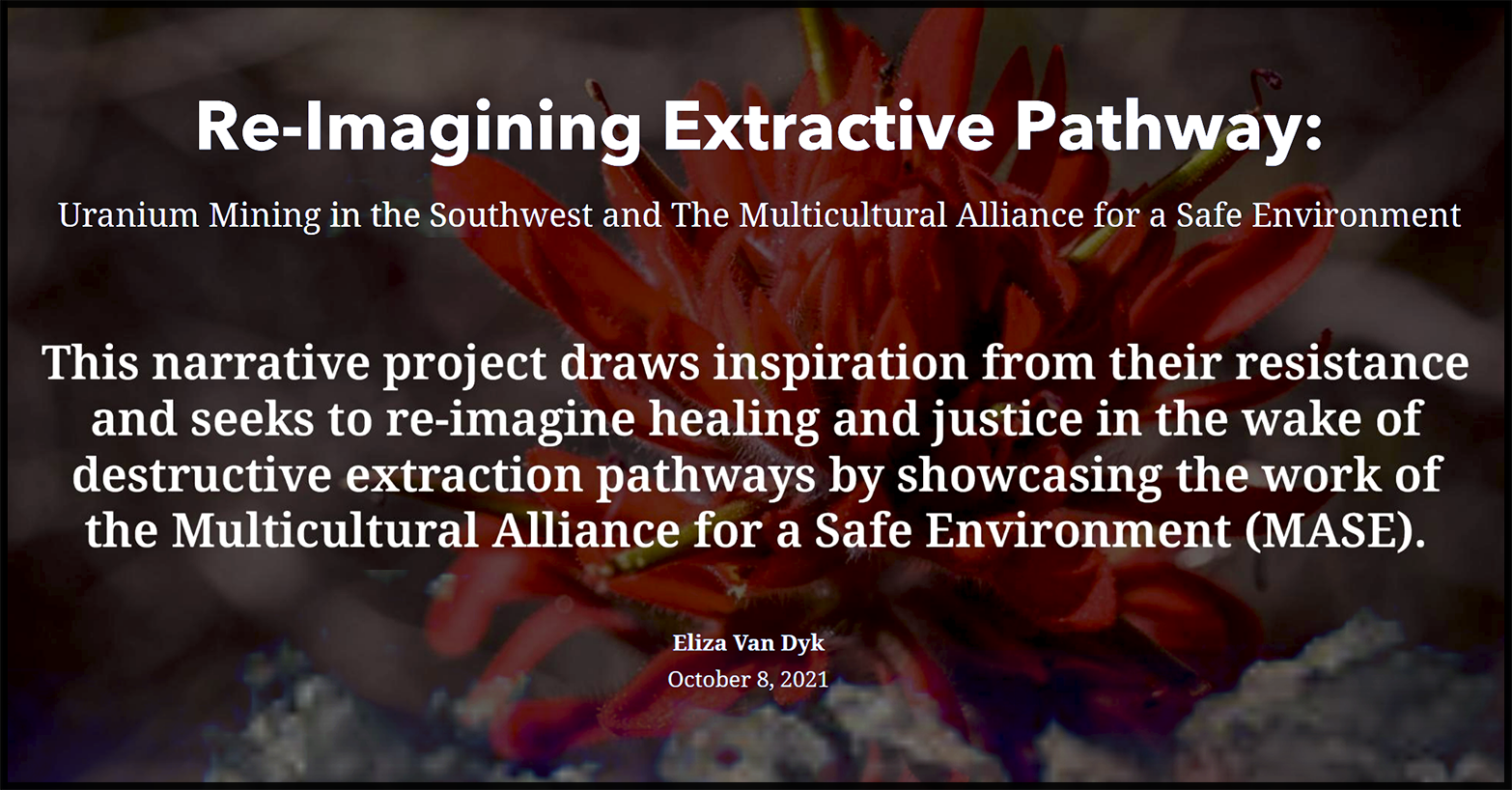Battle for the Wild West: Sacred Landscape or Exploitable Commodity?
In February, MASE organizer, Nadine Padilla, New Mexico Environmental Law Center attorney, Eric Jantz, and Southwest Research and Information Center’s director of Uranium Impact Assessment Program, Chris Shuey, were interviewed for an article that appeared in the Colorado College’s Cipher Magazine. Following is the resulting article. By Joel Minor The story of the Wild West is the story of how a dry, sparsely populated, and visibly stunning landscape was viewed by very different cultures, and the tragic clash of those cultures over their disparate views of the landscape. To prospectors and homesteaders, the land was a commodity — it was a resource to be exploited for material gain. To far-away officials in Washington, and a growing band of bureaucrats and lawyers, the land was an opportunity to build a great new society, rooted in widespread land ownership and prosperity. And to the Native American Tribes that had populated the West for millennia, the landscape was sacred. The people were a part of the land, and the land was a part of the people. Although the Wild West of yore is no longer, in truth, the same clash of cultures, with remarkably similar players and issues, continues today. The use of the few remaining pockets of a truly wild Western landscape remains at the center of a dispute between corporate natural resource development interests, government officials, and the local people, who in many areas are Native American. I got a rare glimpse into the paltry remains this still-Wild West on an equally rare rainy day in the desert this summer, when I pulled up at a Denny’s in Gallup, New Mexico. Gallup is the epitome of the Wild West. Deep in the endless pink sagebrush-and-cacti mesas of northwest New Mexico, the town’s has a largely Native American population, with sizeable Hispanic and Anglo contingents. Its scenic location on Route 66, over an hour from any nearby city, made it the site of choice for filming Westerns in the ‘40s, ‘50s, and ‘60s. I was visiting on business. As an intern at the Santa Fe based New Mexico Environmental Law Center (NMELC), I was sent to meet with several Navajo men who had worked at the Churchrock Uranium Mill prior to its closure and its conversion into a Superfund site in 1983. In 1979, Churchrock was the site of the largest radioactive accident in U.S. history, in which 1100 tons of radioactive waste and 93 million gallons of irradiated water were released into the Puerco River, flowed through Gallup, and ended up at least 80 miles downstream. The spill killed off livestock, caused widespread sickness, and likely lead to elevated cancer rates in the surrounding Navajo Nation. To date, however, no comprehensive epidemiological study has been conducted of the area’s residents, and as such, little to no compensation has been offered to the victims. The issue of uranium mining — past and future — continues to divide area residents. According to the US Energy Information Administration, New Mexico contains about a quarter of the country’s remaining uranium reserves. Inescapable safety issues, a mounting pile of radioactive waste with nowhere safe to store it, and the Three Mile Island and Chernobyl meltdowns drove the powerful nuclear power industry to a halt in the early 1980s. Since 1974, no nuclear power plant has been built in the U.S. But growing scarcity of conventional fuel sources has sparked debate about the need to create more nuclear power in the US — and to create more nuclear power, the country would need more uranium. New Mexico produced half of America’s uranium mined in the US between 1948 and 1988 — the peak of the nuclear era. And if a cabal of mining, utility, uranium enrichment, and defense corporations get their way, the Grants Mineral Belt in Northwest New Mexico may once again be riddled with toxic, radioactive active mine sites. The war between corporate mining interests looking to exploit the Western landscape’s natural resources and Native Americans who are more deeply vested than ever in protecting the remaining wild land that is an integral part of their identity is still being fought as fiercely as ever. And there is no better battle to illustrate the clash of worldviews than the legal fight over mining uranium in Northwest New Mexico. The Legacy of the Churchrock Spill Nadine Padilla is the Coordinator of the Multicultural Alliance for a Safe Environment, a coalition of community-based grassroots organizations that have been adversely impacted by previous uranium mining in New Mexico. MASE is composed of five core groups which represent the various cultures and ethnicities of northwestern New Mexico, including the Laguna Pueblo, Acoma Pueblo, the Navajo Nation, and Anglo and Hispanic ranching communities. Padilla herself is an active and vocal opponent of the opening of new uranium mines in the Grants region. One proposed new mine site is directly adjacent to the site of the 1979 Churchrock Spill, suggested to Padilla that we might not have learned the tough lesson from the devastation of the Spill the first time around. “The Spill was more than 30 years ago, but people continue to suffer from the effects of living in a contaminated area,” Padilla explains. “The Churchrock spill was a failure by the company and all the state and federal agencies that are responsible for protecting our environment and our communities. The problem was largely ignored by everyone responsible and local communities were left to deal with the country’s largest radioactive spill on their own. The fact that state and federal agencies have already or are considering permitting new mines with previous contamination not yet addressed shows that the lessons offered from the Churchrock Spill weren’t learned.” The proposed new Chruchrock Mine operation is under the control of Uranium Resources International/Hydro Resources International, and is located in between the towns of Churchrock and Crownpoint, in the heart of the Navajo Nation Reservation, which is comparable in size to Ireland. Seeing the devastating human health and environmental impacts of uranium mining, the Navajo Nation banned uranium mining years ago. Nevertheless, URI has been fighting to open a new Churchrock mine since April 1989 (for perspective, the month I was born). The mine would use a controversial mining technique known as in-situ leaching (ISL), in which toxic chemicals are injected into the groundwater and used to loosen up the uranium trapped deep within the earth. Last year, URI won two critical cases allowing it to move forward in the 10th Circuit Court of Appeals. One challenged whether its mine would technically be located within Navajo jurisdiction (and thus be illegal), and the other challenged the safety of ISL mining. Eric Jantz is a Staff Attorney at the NMELC and is the lead attorney in the suit challenging the safety of ISL mining. The case specifically challenges the Nuclear Regulatory Commission’s decision that the ISL mining at the site, despite its potential to contaminate the only source of drinking water for over 10,000 people, is safe. To him, the matter is an issue of environmental justice. “The HRI case implicates environmental justice because the ISL mine will most likely pollute Church Rock’s and Crownpoint’s underground drinking water supplies, since no ISL mine has ever failed to pollute the aquifer in which mining occurred,” Jantz explains. “It’s worth noting that there are no ISL projects taking place or proposed for the drinking water supplies of affluent or Anglo communities anywhere in the US, even though there are ISL amenable deposits in such communities in Santa Fe County New Mexico and South Texas.” Sheriffs, and Outlaws The Wild West of legend was the site of ongoing battles between sheriffs and outlaws. In the modern day battle of exploiting vs respecting the landscape, a coalition of ‘good guys’ is still fighting the bad guys. Colorado College senior Kelsey Speaks is one of the modern day good guys. Like Jantz, she too is concerned about environmental justice in the Grants Mineral Belt, and is skeptical of ISL mining. “In situ leach mining.. uses significant water resources. As an arid region, it is inexcusable to waste water on these projects,” she said. “Leach mining liberates radioactive material from the sides of aquifers… [C]racks may exist in geological formations that could allow radioactive material to migrate to other aquifers. Leach mining puts millions of gallons of precious water at risk of contamination. Additionally, the industry has not demonstrated that it can restore contaminated water to its original condition.” One reason that the uranium industry has suggested that ISL mining is safer than conventional “room and pillar” mining is that workers do not have to spend time underground, where they are exposed to often-fatal levels of radon gas. The dangers of conventional mining techniques hits close to home for Speaks. “My grandfather worked as a uranium ore hauler in Utah and Arizona during the 1960s,” she said. “He passed away in November 2008 due to complications from radiation-related lung and kidney conditions. He explained that the government and the uranium mining companies never informed workers of the dangers of working with radioactive material and provided no workplace protection to workers.” Speaks acted on her concerns two summers ago, when she and two other CC students worked with the Post ’71 Uranium Workers Committee (Post 71) in a program sponsored by the Southwest Studies Department’s Regional Research Initiative. Currently, only former uranium workers who worked prior to 1971 are eligible for compensation from the Federal Government. Speaks and her fellow CC students helped to analyze and report on data from a survey of over 1300 uranium workers employed after 1971. The research contributed to legislation introduced by New Mexico Senator Tom Udall (D), which would allow compensation for workers who worked after 1971. Although the bill stalled in the Senate last year, Senator Udall plans to reintroduce it in this legislative session. Coalitions between organizations like MASE, the NMELC, and Post ’71 are critical in the anti-uranium mining movement. According to Padilla, “Today, our communities are some of the poorest counties in New Mexico where the unemployment rate hovers around 50-70% and where many homes lack electricity and running water.” Another organization advocating for vulnerable communities in northwest New Mexico is the Southwest Research and Information Center, or SRIC. Chris Shuey is the Director of SRIC’s Uranium Impact Assessment Program. Shuey was hired at SRIC in 1981, as a young journalist “researching and writing stories on the early Navajo uranium miners who were dead and dying in the mid to late 1970s, and the plight of their widows.” He has been a tireless advocate for environmental justice ever since. Like Padilla, Shuey is concerned that we have not learned from the lesson of the Churchrock Spill. Well versed in both policy science, Shuey explained that “Elevated gamma radiation from mining and milling impacts could still be observed outside of the mine and mill sites 20 years after mining and milling ended in the early to mid 1980s.” He went on to explain that when underground hard-rock uranium is dissolved in the ISL mining process, it becomes highly mobile. It is extremely hard to predict where it will go, but, in spite of this fact, regulatory agencies, including the NRC have authorized ISL mining at Churchrock, where the groundwater supply is the only source of drinking water for the residents in the desert above ground. The Ultimate Battle for the Wild West: Sacred Landscape or Exploitable Commodity? But the Crownpoint/Churchrock Mine is hardly the only proposed mine in the area. Another proposed new mine is Strathmore Resource’s Roca Honda Project, located on Mt. Taylor, a holy site of the Navajo Nation, the Hopi Tribe, and the Laguna, Acoma, and Zuni Pueblos. Although the mine is ostensibly a project of Wyoming-based Strathmore Resources, it is largely financed by Sumitomo Corporation, a Japanese mega-corporation (which coincidentally is also responsible for the largest nuclear accident in Japanese history). Sumitomo has indicated that it may intends to export some or all of the mine’s uranium back to Japan, which certainly weakens the argument that more uranium mining is crucial to future US power generation. “Mount Taylor is a place of great cultural importance. It is a sacred area that connects us to our past, as far back to our creation stories,” Padilla said. “It is a place utilized and honored in various prayers and ceremonies for many tribes. Many people go to Mt. Taylor to collect herbs and medicinal plants. To us, Mt. Taylor is a living entity that needs to be respected and cared for.” Jantz shares Padilla’s concern over the implications of mining at Mt. Taylor. “It represents a fundamental conflict between the Western concept of sacred places as discreet structures that are specifically dedicated to be a sacred place (a church), and the indigenous concept of entire landscapes as sacred,” he said. “It also implicates a conflict between the sacredness of a landscape in indigenous worldviews versus the notion of landscapes as a commodity in the Western worldview.” While I had long been outraged by the sub-human treatment of the Native American and other workers at northwest New Mexico uranium mines, I didn’t see the issue as one of two clashing worldviews until the rainy day when I met up with a former uranium worker at Denny’s. True to my family’s cowboy roots, I consider myself somewhat of a Denny’s pro. I’ve spent more than my fair share of time in identical tourquoise and beige establishments throughout rural and suburban Colorado, enjoying remarkably identical greasy eggs and syrup saturated pancakes. So I was very much surprised when the Navajo man I was eating lunch with stopped me before I took the last bite of my Veggie-Cheese Omelette. “You need to leave some on your plate,” he told me. “It’s an offering to the gods. It’s how we do things.” I was taken aback. In a complex world of decades-long legal disputes over complex geochemistry, epidemiology, and property rights, there truly remains an element of Cowboy vs. Indian culture clash. We lost the Wild West the first time because we erred too far to the side of the cowboys — to the side of viewing the Western landscape as a commodity. Maybe this time around, it’s the Indian’s turn — it’s time to view the landscape as sacred. We might not get to eat every bite of our Denny’s Grand Slam, but I’m pretty sure that our society could do without the extra calories in this day and age.





